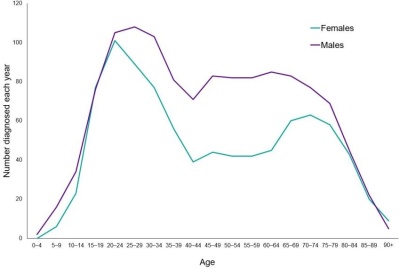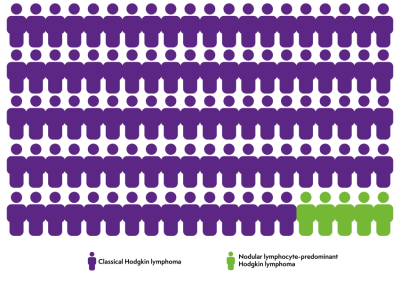Hodgkin lymphoma is a type of cancer that affects the lymphatic system. The lymphatic system is part of the immune system.
About Hodgkin lymphoma
Around 2,000 people are diagnosed with Hodgkin lymphoma (HL) every year in the UK. It is the most common type of lymphoma to affect younger adults (aged 18 to 25). People aged 75 and over are also more at risk.

Hodgkin Lymphoma is divided into:
- Classical Hodgkin lymphoma (CHL) – this is much more common
- Nodular lymphocyte-predominant Hodgkin Lymphoma (NLPHL)
These 2 types of Hodgkin lymphoma are treated differently:
- CHL generally needs treatment at the time of diagnosis (read about treatment options)
- In certain circumstances, NLPHL will not need treatment initially – just monitoring by your clinical team for many years. Find out more about low-grade lymphomas
CHL can be further divided in different types when examined under a microscope (histologically):
- Nodular sclerosis
- Mixed cellularity
- Lymphocyte-rich
- Lymphocyte-depleted
These ‘histological types’ don’t affect what treatment you need.

The most common symptom is a swelling in the neck, armpit or groin – usually a painless lump.
Other symptoms can include:
- Night sweats
- Unintentional weight loss
- High temperature (fever)
- Persistent cough or feeling of breathlessness
- Persistent itching of the skin all over the body
For patients aged 16 to 24, we have a Teenage and Young Adult (TYA) team who provide specialist support for young people affected by Hodgkin lymphoma. They also arrange activities for young people with cancer.
When you are diagnosed, your care will be discussed at a multidisciplinary team meeting (MDT) where different specialists will consider the best treatment options for you. They discuss the risks and benefits of treatment for the greatest chance of a cure while trying to minimise side-effects or complications.
Your doctor will discuss this with you so you can decide what is right for you.
Treatment depends on a range of factors including the size, stage and location of your tumour. It may also depend on your age and general health.
Unless you are frail or have other complex medical issues, the aim of first line (initial) treatment in classical Hodgkin lymphoma (CHL) is disease cure – through chemotherapy with or without additional radiotherapy.
In lymphoma resistant to treatment (refractory disease) or if lymphoma returns after treatment (relapse), we offer a wide range of treatment options at The Clatterbridge Cancer Centre.
Treatments include:
- Chemotherapy
- Radiotherapy
- Targeted treatments and antibody therapy
- Steroids
- Stem cell transplants
- Clinical trials
- Supportive treatments (such as blood transfusions)
- Treatment to control symptoms (palliative care)
Our Lymphoma and CLL team details are on our general lymphoma page.
Our Cancer Information and Support Centres can provide individualised help and support for patients and families affected by cancer. The team’s main base is in Clatterbridge Cancer Centre – Liverpool but they also work at our Aintree and Wirral hospitals.
There are also local Macmillan services in other hospitals across our region.
External sites that offer extra support and information about Hodgkin lymphoma include: